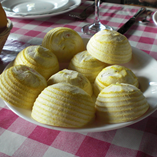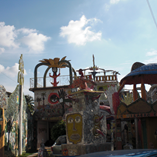Our next stop is the coffee plantation. This was one of the most important cafetals in the whole region. The ruins here have been reconstructed to provide a learning experience, as well as to recreate the plantation owner’s house – which is now a restaurant.
Auriele leads us up the hill from the bus (careful now….it’s steep and really uneven!) until we regroup by the house. It is simply stunning up here. You can see most so much of the Sierra del Rosario from up here. The views are stunning – as is all the different flora and fauna Auriele points out.
We continue walking up (up, up!) this time on the terraces recreated to explain how the coffee was planted, then picked and dried. At the very top of the terraces was a wide open space of stone, where the coffee beans were dried. Then they were transferred to the big “wheel” house, where horses (not Auriele as you will see below) pulled the huge stone wheel around on top of the beans to shell/husk them. Pretty interesting!
Now, it is on to the actual community or town of Las Terrazas. A short bus ride away, down the winding little mountain roads to a valley with lakes and the community’s housing projects. It is a gorgeous area- the sparkling lakes, wild life, animals and sleepy village life. Again, stunning scenery.
We tour the community, walking past the little cottages that dot the lakeshore and hills. There are quite a number of artists here, and we visit a couple. First, Lester Campa, who is world renowned for his artwork which features political and environmental messages. He has traveled around the world with art shows in numerous countries. Some of his more famous works include images of John Lennon and Che Gueverra – he sort of morphs the 2 together in one composite. It’s pretty amazing. He is also famous for his Ceiba Tree paintings and sketches. The Ceiba has a spiritual 
Next we head to the studio of Ariel – who does everything on recycled paper. Outside his small show room is a large enclosed space where he is recycling and creating his canvasses and paper.
We end up buying one card depicting Las Terrazas. It’s a beautiful print – including the embossed envelope – and we figure we can frame it when we get home.
Now it is time for lunch! We are eating at a State run restaurant called Campesino – which roughly translates to farmer (or peasant – but since we are in farm land….). This is actually a farm, and we are chasing the chickens and peacocks from the eating area. It is called the “Union” farm because two rivers unite here. The setting is great – underneath a huge open sided palapa, with a band serenading us with Cuban country music.
This is the best meal so far – really good smoked/grilled chicken and finally! Ropa Vieja! One of my favorite Cuban foods (on the first night at the hotel when we were ordering our meal, meat was a choice and I asked the waiter if it was Ropa Vieja. He didn’t think too highly of that question, sort of sneered and said something like of course not! Oops – guess it’s more of a country thing!) This is some of the best ever. There are also odd hive looking things in the middle of the table which turn out to be oranges, this wild type of bread that looks like frisbees, and of course red beans and rice and the ubiquitous salad of tomatoes, onions, cucumbers and beets (the Beckstoffers are quite happy since they don’t have to share the beets with any of us at the table!).
We get a few minutes to wander after lunch, and stretch our legs. There is another huge pit area for cooking and another eating area with a bar. All very rustic and hidden on this little dirt lane that leads up the hill to the farm house.
Back to town we now go to visit Café de Maria – 
…and Maggi has the coffee with liquor (some sort of odd fruit…not quite recalling exactly what – but exotic for sure!).
I’ve probably not done this eco-community or the biosphere justice. But if you want to read more, there’s a great paper by Business Enterprise for Sustainable Travel (BEST) on the web at:
It’s good reading if you are interested!
So, now it’s time to head back to Habana, so we bid adieu to Ariele and start the journey home. On our way, though, we make a pit stop in a little neighborhood called Jaimanitas, in Miramar, to visit “Fusterland”, the home of the artist Jose Fuster. This is Gaudi on steroids, or more drugs than usual, or something like that! Oy! It’s mosaic central – every square inch of the house – even his neighbors’ homes – is covered in small little pieces of ceramic. He wanted to make his studio a place where he could live with art – and – well – he’s certainly succeeded! He funds his creations – and his neighbors’ decorations from sales of his ceramics and paintings. Pictures are definitely worth a 1000 words here – so we’ll leave you to the viewing:
We all got a little creative here with our photo taking…Richard & Maggi, probably a little more than us – but still – very fun!
And a final Fusterlandia pix:
Gotta love it!
Next up – dinner and drinks!
















































No comments:
Post a Comment